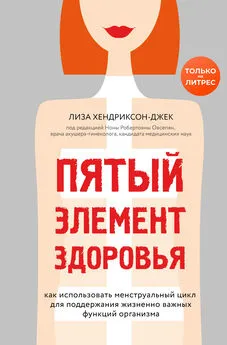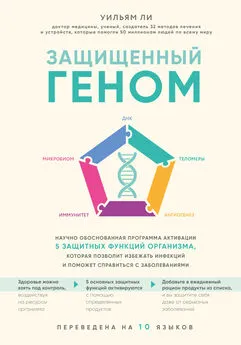Лиза Хендриксон-Джек - Пятый элемент здоровья. Как использовать менструальный цикл для поддержания жизненно важных функций организма
- Название:Пятый элемент здоровья. Как использовать менструальный цикл для поддержания жизненно важных функций организма
- Автор:
- Жанр:
- Издательство:Литагент 5 редакция
- Год:2020
- Город:Москва
- ISBN:978-5-04-104425-1
- Рейтинг:
- Избранное:Добавить в избранное
-
Отзывы:
-
Ваша оценка:
Лиза Хендриксон-Джек - Пятый элемент здоровья. Как использовать менструальный цикл для поддержания жизненно важных функций организма краткое содержание
«Почти» – потому что у женщин есть пятый показатель здоровья, на который, к сожалению, все еще мало кто обращает внимание, – это менструальный цикл. Короткий или длинный, регулярный или непредсказуемый – цикл может быть очень разным, и каждый его параметр, каждое изменение служат индикатором той или иной проблемы в организме. Планируете вы беременность или нет, овуляция имеет значение для поддержания здоровья.
Автор этой книги расскажет, что именно влияет на состояние менструального цикла, и научит вас составлять его график для максимально точного и удобного отслеживания различных изменений и контроля здоровья.
Пятый элемент здоровья. Как использовать менструальный цикл для поддержания жизненно важных функций организма - читать онлайн бесплатно ознакомительный отрывок
Интервал:
Закладка:
91. Weber, Anne M., Cleve Ziegler, Jerome L. Belinson, Allison R. Mitchinson, Theresa Widrich, and Victor Fazio. “Gynecologic history of women with inflammatory bowel disease.” Obstetrics & Gynecology 86, no. 5 (1995): 843–847; Saha, Sumona, Ying-Qi Zhao, Samir A. Shah, Silvia Degli Esposti, Sheldon Lidofsky, Sana Salih, Renee Bright et al. “Menstrual cycle changes in women with inflammatory bowel disease: a study from the ocean state Crohn’s and colitis area registry.” Inflammatory Bowel Diseases 20, no. 3 (2014): 534–540.
92. Sekhar, Rajagopal V., Sanjeet G. Patel, Anuradha P. Guthikonda, Marvin Reid, Ashok Balasubramanyam, George E. Taffet, and Farook Jahoor. “Deficient synthesis of glutathione underlies oxidative stress in aging and can be corrected by dietary cysteine and glycine supplementation.” The American Journal of Clinical Nutrition 94, no. 3 (2011): 847–853.
93. Amores-Sánchez, Marı́a Isabel, and Miguel Ángel Medina. “Glutamine, as a precursor of glutathione, and oxidative stress.” Molecular Genetics and Metabolism 67, no. 2 (1999): 100–105.
94. Agarwal, Ashok, Anamar Aponte-Mellado, Beena J. Premkumar, Amani Shaman, and Sajal Gupta. “The effects of oxidative stress on female reproduction: a review.” Reproductive Biology and Endocrinology 10, no. 1 (2012): 10–49; Ruder, Elizabeth H., Terryl J. Hartman, and Marlene B. Goldman. “Impact of oxidative stress on female fertility.” Current Opinion in Obstetrics & Gynecology 21, no. 3 (2009): 219–222.
95. Hao, Wei-Long, and Yuan-Kun Lee. (2004). “Microflora of the gastrointestinal tract.” Public Health Microbiology. New York, NY: Humana Press, 491–502.
96. Quigley, E.M. “Gut bacteria in health and disease.” Gastroenterology & Hepatology 9, no. 9 (2013): 560–569.
97. Guarner, Francisco, and Juan-R. Malagelada. “Gut flora in health and disease.” The Lancet 361, no. 9356 (2003): 512–519; Jandhyala, Sai Manasa, Rupjyoti Talukdar, Chivkula Subramanyam, Harish Vuyyuru, Mitnala Sasikala, and D. Nageshwar Reddy. “Role of the normal gut microbiota.” World Journal of Gastroenterology 21, no. 29 (2015): 8787.
98. Forsythe, Paul, Nobuyuki Sudo, Timothy Dinan, Valerie H. Taylor, and John Bienenstock. “Mood and gut feelings.” Brain, Behavior, and Immunity 24, no. 1 (2010): 9–16; Kinross, James M., Ara W. Darzi, and Jeremy K. Nicholson. “Gut microbiome-host interactions in health and disease.” Genome Medicine 3, no. 3 (2011): 14–26; Dash, Sarah, Gerard Clarke, Michael Berk, and Felice N. Jacka. “The gut microbiome and diet in psychiatry: focus on depression.” Current Opinion in Psychiatry 28, no. 1 (2015): 1–6; Strati, Francesco, Duccio Cavalieri, Davide Albanese, Claudio De Felice, Claudio Donati, Joussef Hayek, Olivier Jousson et al. “New evidences on the altered gut microbiota in autism spectrum disorders.” Microbiome 5, no. 1 (2017): 24–35; Severance, Emily G., Emese Prandovszky, James Castiglione, and Robert H. Yolken. “Gastroenterology issues in schizophrenia: why the gut matters.” Current Psychiatry Reports 5, no. 17 (2015): 1–10.
99. Frank, Daniel N., Allison L. St Amand, Robert A. Feldman, Edgar C. Boedeker, Noam Harpaz, and Norman R. Pace. “Molecular-phylogenetic characterization of microbial community imbalances in human inflammatory bowel diseases.” Proceedings of the National Academy of Sciences 104, no. 34 (2007): 13780–13785.
100. Marco, Maria L., Dustin Heeney, Sylvie Binda, Christopher J. Cifelli, Paul D. Cotter, Benoit Foligné, Michael Gänzle et al. “Health benefits of fermented foods: microbiota and beyond.” Current Opinion in Biotechnology 44 (2017): 94–102; Hendrickson-Jack, Lisa. “FFP 066 | Gut Health and Fertility | Preconception Nutrition | GAPS Diet | Dr. Natasha Campbell-McBride.” Fertility Friday Podcast. Podcast Audio, February 26, 2016. fertilityfriday.com/166
101. Roche, Andrea, Erika Ross, Nicole Walsh, Kierin O’Donnell, Alyssa Williams, Marjorie Klapp, Nova Fullard, and Sari Edelstein. “Representative literature on the phytonutrients category: Phenolic acids.” Critical Reviews in Food Science and Nutrition 57, no. 6 (2017): 1089–1096; Zhu, Fengmei, Bin Du, and Baojun Xu. “Anti-inflammatory effects of phytochemicals from fruits, vegetables, and food legumes: A review.” Critical Reviews in Food Science and Nutrition (2017): 1–11; Chung, Raymond Tsz Man. “Detoxification effects of phytonutrients against environmental toxicants and sharing of clinical experience on practical applications.” Environmental Science and Pollution Research 24, no. 10 (2017): 8946–8956; Aga, Miho, Kanso Iwaki, Yasuto Ueda, Shimpei Ushio, Naoya Masaki, Shigeharu Fukuda, Tetsuo Kimoto, Masao Ikeda, and Masashi Kurimoto. “Preventive effect of Coriandrum sativum (Chinese parsley) on localized lead deposition in ICR mice.” Journal of Ethnopharmacology 77, no. 2–3 (2001): 203–208.
102. Fallon Morell, Sally. (2017). Nourishing Fats: Why We Need Animal Fats for Health and Happiness. New York, NY: Grand Central Life & Style.
103. Hansen, S.O., and Ulla Breth Knudsen. “Endometriosis, dysmenorrhoea and diet.” European Journal of Obstetrics & Gynecology and Reproductive Biology 169, no. 2 (2013): 162–171.
104. Chavarro, Jorge E., Janet W. Rich-Edwards, Bernard A. Rosner, and Walter C. Willett. “Dietary fatty acid intakes and the risk of ovulatory infertility.” The American Journal of Clinical Nutrition 85, no. 1 (2007): 231–237.
Глава 13
1. Mullington, Janet M., Monika Haack, Maria Toth, Jorge M. Serrador, and Hans K. Meier-Ewert. “Cardiovascular, inflammatory, and metabolic consequences of sleep deprivation.” Progress in Cardiovascular Diseases 51, no. 4 (2009): 294–302; Knutson, Kristen L., Karine Spiegel, Plamen Penev, and Eve Van Cauter. “The metabolic consequences of sleep deprivation.” Sleep Medicine Reviews 11, no. 3 (2007): 163–178; Nakata A. “Work hours, sleep sufficiency, and prevalence of depression among full-time employees: a community-based cross-sectional study.” Journal of Clinical Psychiatry 72 (2011): 605–14; Kakizaki, M., S. Kuriyama, T. Sone, et al. “Sleep duration and the risk of breast cancer: the Ohsaki Cohort Study.” British Journal of Cancer 99 (2008):1502–1505; Alvarenga, Tathiana A., Camila Hirotsu, Renata Mazaro– Costa, Sergio Tufik, and Monica L. Andersen. “Impairment of male reproductive function after sleep deprivation.” Fertility and Sterility 103, no. 5 (2015): 1355–1362.
2. Lawson, Christina C., Elizabeth A. Whelan, Eileen N. Lividoti Hibert, Donna Spiegelman, Eva S. Schernhammer, and Janet W. Rich-Edwards. “Rotating shift work and menstrual cycle characteristics.” Epidemiology 22, no. 3 (2011): 305–312; Stocker, Linden J., Nicholas S. Macklon, Ying C. Cheong, and Susan J. Bewley. “Influence of shift work on early reproductive outcomes: a systematic review and meta-analysis.” Obstetrics & Gynecology 124, no. 1 (2014): 99–110; Chung, Fen-Fang, Chuan-Chiang Chou Yao, and Gwo-Hwa Wan. “The associations between menstrual function and lifestyle/working conditions among nurses in Taiwan.” Journal of Occupational Health 47, no. 2 (2005): 149–156; Goldstein, Cathy A., and Yolanda R. Smith. “Sleep, Circadian Rhythms, and Fertility.” Current Sleep Medicine Reports 2, no. 4 (2016): 206–217; Lauria, Laura, Terri J. Ballard, Massimiliano Caldora, Clelia Mazzanti, and Arduino Verdecchia. “Reproductive disorders and pregnancy outcomes among female flight attendants.” Aviation, Space, and Environmental Medicine 77, no. 5 (2006): 533–539; Grajewski, Barbara, Elizabeth A. Whelan, Christina C. Lawson, Misty J. Hein, Martha A. Waters, Jeri L. Anderson, Leslie A. MacDonald et al. “Miscarriage among flight attendants.” Epidemiology 26, no. 2 (2015): 192–203.
3. Marino, Jennifer L., Victoria L. Holt, Chu Chen, and Scott Davis. “Shift Work, hCLOCK T3111C polymorphism, and endometriosis risk.” Epidemiology (2008): 477–484.
4. Watson, Nathaniel F., M. Safwan Badr, Gregory Belenky, Donald L. Bliwise, Orfeu M. Buxton, Daniel Buysse, David F. Dinges et al. “Joint consensus statement of the American Academy of Sleep Medicine and Sleep Research Society on the recommended amount of sleep for a healthy adult: methodology and discussion.” Journal of Clinical Sleep Medicine 11, no. 8 (2015): 931–952; Ford, Earl S., Timothy J. Cunningham, and Janet B. Croft. “Trends in self-reported sleep duration among US adults from 1985 to 2012.” Sleep 38, no. 5 (2015): 829–832.
5. Gradisar, Michael, Amy R. Wolfson, Allison G. Harvey, Lauren Hale, Russell Rosenberg, and Charles A. Czeisler. “The sleep and technology use of Americans: findings from the National Sleep Foundation’s 2011 Sleep in America poll.” Journal of Clinical Sleep Medicine 9, no. 12 (2013): 1291–1299.
6. Iyengar, Bhanu. “The melanocyte photosensory system in the human skin.” Springer Plus 1, no. 2 (2013): 1–18; Tsutsumi, Moe, Kazuyuki Ikeyama, Sumiko Denda, Jotaro Nakanishi, Shigeyoshi Fuziwara, Hirofumi Aoki, and Mitsuhiro Denda. “Expressions of rod and cone photoreceptor-like proteins in human epidermis.” Experimental Dermatology 18, no. 6 (2009): 567–570.
7. Graham, Charles, Mary R. Cook, Mary M. Gerkovich, and Antonio Sastre. “Examination of the Melatonin Hypothesis in Women Exposed at Night to EMF or Bright Light.” Environmental Health Perspectives (2001): 501–507; Bojkowski, C.J., M.E. Aldhous, J. English, C. Franey, A.L. Poulton, D.J. Skene, and J. Arendt. “Suppression of nocturnal plasma melatonin and 6-sulfatoxymelatonin by bright and dim light in man.” Hormone and Metabolic Research 19, no. 09 (1987): 437–440.
8. DeFelice, Joy, R. Kambic, and R. DeFelice. “Light elimination therapy for the treatment of infertility: A pilot study.” Paper presented at the Billings Ovulation Method of America Meeting, Spokane, WA (2002): 1–4; Lee Barron, Mary. “Light exposure, melatonin secretion, and menstrual cycle parameters: an integrative review.” Biological Research for Nursing 9, no. 1 (2007): 49–69; Gamble, K.L., D. Resuehr, and C.H. Johnson. “Shift work and circadian dysregulation of reproduction.” Frontiers in Endocrinology 4 (2013): 92.
9. Figueiro, M.G., and M.S. Rea. “The effects of red and blue lights on circadian variations in cortisol, alpha amylase, and melatonin.” International Journal of Endocrinology 2010 (2009): 829351–829351.
10. Gooley, Joshua J., Kyle Chamberlain, Kurt A. Smith, Sat Bir S. Khalsa, Shantha M.W. Rajaratnam, Eliza Van Reen, Jamie M. Zeitzer, Charles A. Czeisler, and Steven W. Lockley. “Exposure to room light before bedtime suppresses melatonin onset and shortens melatonin duration in humans.” The Journal of Clinical Endocrinology & Metabolism 96, no. 3 (2010): E463-E472.
11. Leproult, Rachel, Egidio F. Colecchia, Mireille L’Hermite-Balériaux, and Eve Van Cauter. “Transition from dim to bright light in the morning induces an immediate elevation of cortisol levels.” The Journal of Clinical Endocrinology & Metabolism 86, no. 1 (2001): 151–157; Scheer, F.A.J.L., and Ruud M. Buijs. “Light affects morning salivary cortisol in humans.” The Journal of Clinical Endocrinology & Metabolism 84 (1999): 3395–3398.
12. Danilenko, Konstantin V., and Elena A. Samoilova. “Stimulatory Effect of Morning Bright Light on Reproductive Hormones and Ovulation: Results of a Controlled Crossover Trial.” PLOS Clinical Trials 4, no. 2 (2007).
13. Burke, Tina M., Rachel R. Markwald, Andrew W. McHill, Evan D. Chinoy, Jesse A. Snider, Sara C. Bessman, Christopher M. Jung, John S. O’Neill, and Kenneth P. Wright. “Effects of caffeine on the human circadian clock in vivo and in vitro.” Science Translational Medicine 7, no. 305 (2015): 305ra146; Landolt, Hans-Peter, Esther Werth, Alexander A. Borbély, and Derk-Jan Dijk. “Caffeine intake (200 mg) in the morning affects human sleep and EEG power spectra at night.” Brain Research 675, no. 1 (1995): 67–74.
Читать дальшеИнтервал:
Закладка:









